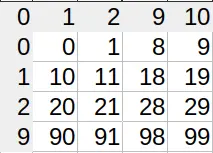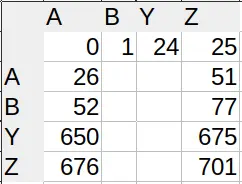Explanation (which might be wrong, since I’m writing this after banging my head against a wall. Please do correct me if I’m wrong):
In regular numbering systems (i.e., decimal), we exhaust all 10 digits (0–9) before we reach two-digit numbers. The first number to require 3 digits is 10². The first to use 4 is 10³, and so on.
In music intervals, there is no “0”. The interval c’–c’, for instance, is called a prime (1). This has the funny consequence that moving by a fifth and then by a fourth doesn’t land you on the ninth, but the octave (8). Moving by an octave and then another octave gets you to the 15th, not the 16th.
In Excel, shit hits the fan when you need to convert column names (A, B, C…) to numbers (0, 1, 2…). Since we use 26 characters as our ‘digits’, we’re in the hexavigesimal system. Knowing what I told you in the first paragraph, you’d expect the first double-digit column (AA) to be 26. And you’re right.
However, when do we need 3 digits? Which column is column AAA? A sane person would say it’s 26², so 676. Ha! No. Column number 676 is actually ZA. What gives? Well, we only ditch the zero for single digit numbers. All subsequent columns actually use 27 different characters, the ‘empty character’ being one of them. That’s where we get the ‘single digit’ – there actually is a second digit, only it’s empty.
So the column AAA actually has index 702, or 26×27. Which index does the column AAAA have? 26×27². The system of adding powers of the base works, only we changed bases midway through.
You can see the lopsidedness in the index lookup table (I’m not displaying all characters for brevity). Sane number systems have square tables. Excel’s is 26×27 (shown are 4×5).



I’m a bit too tired and tipsy to fully wrap my head around this but I’m just as furious as you are!
This has the funny consequence that moving by a fifth and then by a fourth doesn’t land you on the ninth, but the octave (8). Moving by an octave and then another octave gets you to the 15th, not the 16th.
This is worded confusingly. The reason for this is simply because you include the base note when you start counting, so if you stop midway and stack another interval on top, you have to account for that stop because it decreases the total travel distance by one.
This is done to actually increase consistency. If you start at c1 and move up an octave and then move up another octave, you stop at c3 which is logical. So you either move 2 octaves or one 15th because 2*8-1 = 15.
Name the prime a “none”, the octave a sept.
Now, 2 “septaves”, c1 to c3, are a 14th. 2*7 = 14.You can make off-by-one intervals work, but you have to constantly juggle some +1s or -1s compared to what we usually use.
If you counted distance in steps, then moving from your front door to your front door would be 0 steps, not one, and moving by 6 steps is twice the distance of 3 steps.
A piano with 5 septaves has 5*7 = 60 keys, wait.
So anyway mathematically one dodecave, one 12th, c1 to c2, has 12 segments, the frequency diffefence is 2. So a second, 2 notes, has 2/12 of that interval, the ratio is 22/12.
A first, a halftone, has 21/12 as its frequency ratio, and a none has 20/12 = 1, the same frequency.No matter if you count physical keys, distance on a keyboard to change a note by, or mathematical frequency in the air, starting at 1 goes against our intuition, and when you try to add or multiply it is easy to get completely wrong results.
PS: You might want to go C to C on your 5 dodecave keyboard, in which case the concept of “started hour” etc. is familiar, you know to add one arriving at 61 keys, and you know that means an assymetry where one C doesn’t have 11 other keys to itself.
The other way around you’d have to subtract 4, so probably subtract 5 and add 1 since you were dealing with 5 tredecaves in your head not 1 base tredecave followed by 4 extension tredecaves.The reason for this is simply because you include the base note when you start counting, so if you stop midway and stack another interval on top, you have to account for that stop because it decreases the total travel distance by one.
I’m arguing that ‘counting the base note’ is necessary because there is no zero. If you travel 1 unit of your favorite unit of length, stop, and move one unit more, you have moved 2 units, not 3 as it is in music. Stops don’t add to or reduce travel distance.
People are focusing on the Excel part, I’ll focus on the maths.
I wish our societies picked base-12 instead of base-10. Divisions in base-12 give you repeating digits less often, and being able to split exactly by 3, 6, 9 and 12₁₀=10₁₂ is far more useful than doing it for 5 and 10₁₀=A₁₂.
Plus 4chan would stop arguing if 0.999… = 1. It would argue instead if 0.BBB… = 1.I wish our societies picked base-12 instead of base-10.
This, right here, is the hill I will die on. Imperial/US customary unit divisions are superior to metric decimalization.
Metric “dozenalisation” would be perfectly viable, and metric-dozenal units would still look nothing like USA units.
I’ll use length for the example. All of them in base 10, just for clarity. (Also the name of the units would be different, but I’m not changing them for this example.)
- metric-decimal: 10⁻³ km = 10⁻² hm = 10⁻¹ dam = 10⁰m = 10¹dm = 10²cm = 10³mm
- metric-dozenal: 12⁻³ km = 12⁻²hm = 12⁻¹ dam = 12⁰m = 12¹dm = 12²cm = 12³mm
- USA units: 1/1760mi = 1yd = 3ft = 3*12 in = 3*12*6 P = 3*12*6*12 p
Are you noticing what the USA units do? They don’t stick to a base.
your argument could be enhanced with the inclusion of survey units.
12 inches to a foot
3 feet in a yard
22 yards in a chain
10 chains in a furlong
8 furlongs in a mile
3 miles in a league
22 yards in a chain
What. I had to websearch this because it sounds too silly, but apparently it’s true.
But, really, even if it used saner numbers (like 12:3:24:8:3), it still feels nothing like a “metric dozenal” would look like. It’s missing the two things the metric system did right:
- All prefixes are unit-agnostic, like they were numbers. For example you can plop “kilo” = 10³ on weight (kilogram), length (kilometre), volume (kilolitre), energy, (kilojoule), etc.
- All prefixes must be an integer power of the base. For example you could make a 10⁸ prefix, even if there’s none, and it would be OK; but you can’t make, say, a 10^(2.447) = 300 one.
Oh, I see you picked a pretty small hill to die in…
This is a very fun implicit question!
First, in decimal, there are 10 symbols: 0-9. When we count from 0 to 9, the next number is 10, not 00 (which is equivalent to 0).
In base 26, there are 26 symbols (A-Z). If one wanted to use these symbols in the same way, A would be equivalent to 0, so 26 is represented by BA, not AA. However, if AA is not the same as A, then we can represent 26 as AA instead of BA.
Basically, in our typical numbering system, the leading digit can’t be 0, so there are 9×10 possible two digit numbers, and 10 possible single digit numbers. However, if the first digit can be 0, meaning, for example, if 03 is not the same as 3, there are 10×10 possible two digit numbers. This second approach is what excel and google sheets use. Column A is not the same as column AA. Hence, you start with single digit column numbers (A-Z). Then you move to two digit column numbers (AA-ZZ), of which there are 26². The last column before triple digits is column 26+26²=702. The first triple digit column number is 26+26²+1=703. Neat!
Comparing this to our system, the first 2 digit number is 10¹=10. The first 3 digit number is 10²=100. The first 4 digit number is 10³=1000.
For Hardcore geeks

Why is there a custom key for 00001010?
because it’s a fake 00001010
I got confused by your explanation, I think partly because of conversion to decimal without specifying whether column A is 0 or 1. To match the row numbering system, I’d assume it’s 1, but mathematically it might be easier to analyze if it starts at 0.
Here’s my attempt to understand it better.
How many spreadsheet rows are 1 digit? 1-9, that’s 9 rows.
How many rows are 2 digit? 10-99, that’s 90 rows.
How many rows are 3 digit? 100-999, that’s 900 rows.
The pattern is: there are 9 × 10^(d-1) rows that are d digits.
Now for columns. How many columns are 1 letter? A-Z, that’s 26.
How many columns are 2 letters? AA-ZZ, that’s 26².
How many columns are 3 letters? AAA-ZZZ, that’s 26³.
The pattern is: there are 26^d columns that are d letters.
Now let’s look at running totals. How many rows are at most 2 digits? 9 + 90 = 99
How many rows are at most 3 digits? 99 + 900 = 999
The pattern is: 10^d - 1 rows are at most d digits.
How many columns are at most 2 letters? 26 + 26² = 26×(1 + 26) = 26×27
How many columns are at most 3 letters? 26×27 + 26³ = 26×(27 + 26²)
Alternatively: 26 + 26² + 26³
I can’t find a more compact way of writing it.
The pattern is: Σ26^k (k from 1 to d) columns are at most d letters
I might be wrong but I don’t think this matches up with what you said, which is 26×27^(d-2) + c (where c is some constant for converting between what we’re trying to measure, probably 1 or -1)
Wait duh, it’s a geometric series. I’m a little out of touch there but online resources are aplenty, so the pattern is:
There are (26^d - 1)×26/25 columns are are at most d letters.
What is with the spike in Excel related memes? I am out of the loop.
I think it’s a viral marketing campaign for the upcoming sequel “Excel 2”.
2Ex – 2Cells
excelectric boogaloo
Excel On The Beach by Kojima
I had to use Excel today. That’s the reason.
I didn’t even notice, all of the excel posts I saw were all from you. You had major influence on my feed lol
bow.gif
I think I saw one that wasn’t from me.
This is called bijective numeration. See here: https://en.wikipedia.org/wiki/Bijective_numeration
I cannot imagine that a significant percentage of Excel power users care what column number ABC is. You use either A1 notation or R1C1 notation based on your need. You don’t have to convert between the two. You can even use the INDIRECT() function to reference a cell either way regardless of your general settings. In VBA, you can use Range(“A1”) or Cells(1,1) to reference cells with either notation. Either are always options. Conversion is not necessary.
This isn’t a question of functionality but just whether a system whether basic arithmetic, music, etc makes logical/intuitive sense.
Imperial measurements using feet, yards, mph, etc instead of metric centimeters, meters, kph, etc. Sure imperial works but it doesn’t make the same sense that metric does. Math can be done in base 2, base 60 or whatever it doesn’t make the same sense as base 10.
Why do you assume I’m doing this inside Excel? I was importing a data sheet into other software. By the time I got my hands on the data, it was an object of the sort
{A: [/*data*/], AA: [/*data*/], B: [/*data*/]}. I had to sort the keys for presentation purposes.In retrospect, sure, there would’ve been easier ways. But at the time I wasn’t aware yet that converting Excel columns to numeric indices isn’t as straightforward as a simple base conversion (like, e.g. from hex to decimal).
Ah, that does make a lot of sense. Excel does not play well with others. It can’t even play nicely with CSV.
Wonder why Excel didn’t use numbers and treat them like an X and Y axis?
You can set that in the options somewhere. Referencing G4 is probably easier for most people than (7,4).
This. I always thought the columns were named, not numbered; this would make it easier for regular humans to work with Excel because of the similarities with a chess board. The original developers would probably have chosen matrix style coordinates in hindsight though.
Reminded me of this: https://xkcd.com/3102/
The music one is because you don’t double count the first octave C.
C D E F G A B C D E F G A B C is 15 notes.
A scale is really only 7 notes when you think about it when you don’t count the octave. But in this case you count the first octave but not the second
Ok, I’m confused, is the blank actually used in the middle of large column labels? Like is “A A” a number? how about "A ", " A ", or even " "? (All are three characters) If not then it seems like the base is 26, so I’m not seeing where the 27 multiplier is coming from, except that it’s also a case where there’s no 0 (like music?) and that might throw things off
Edit: Ok, the comment by Morti explains everything. It’s not the blank, it’s the A ≠ AA so there are more numbers before a digit is added thing.
Why would one need to convert the columns to numbers again? And why wouldn’t you just represent that data in a graph instead?
I’ve done some seriously stupid shit in excel, mostly due to it being the only tool I had. By the time I handed the project off to someone else for maintenance/feature creep, there were VLOOKUP ranges spanning dozens of columns. VLOOKUP doesn’t care what column the target is named, only the offset from the beginning of the range. So being able to calculate CA minus W is pretty handy.
Yes, the project should have been a database. But these things happen when skinflint company meets annoyed amateur: you get a sprawling VBA abomination that, despite making actual developers want to choke a bitch, still works orders of magnitude better than the previous system.
Pray tell how I would graph someone’s address.
And why wouldn’t one just use the =COLUMN() formula to determine the column number if necessary?
Because I wasn’t even using Excel at that point. I was importing an excel sheet.
That’s…not how octaves work. I don’t know how to provide a constructive correction because I don’t understand what you’re saying about 15ths in the first place.
Could you elaborate? I’m a music teacher and it checks out to me.
C4 up a 5th is G4, then up a fourth is C5. C4 to C5 is an octave.
Two octaves is a 15th. In music when the composer wants you play up an octave, they write (typically) 8va. When they want you to play up two octaves, they write (typically) 15va.
That threw me off as well but it checks out.
An interval includes the starting note in its name so e.g. c to g is a 5th because there are 5 notes in it: cdefg. But if you move up a 5th from c you move by 4 steps: c->d, d->e, e->f, f->g.
In the first example we move a 5th and a 4th. So if we start on c we go 4 steps c->g and 3 steps g->c for a total of 7 steps c->c. An interval that represents 7 steps has 8 notes because we count the starting note as well so it is an 8th.
For the scond example we move an 8th and another 8th. So starting on c again we move 7 steps c1->c2 and 7 steps again c2->c3 for a total of 14 steps c1->c3. An interval with 14 steps has 15 notes including the starting one so it is a 15th.









